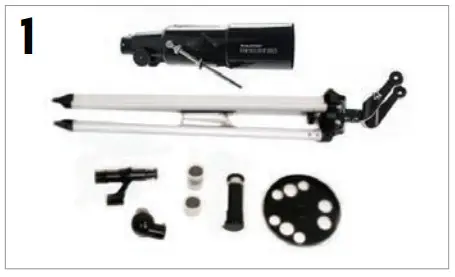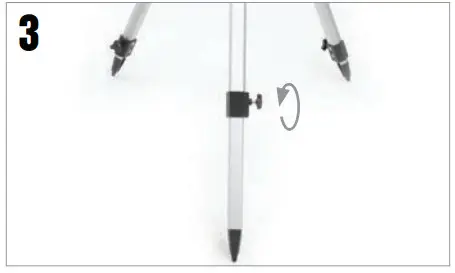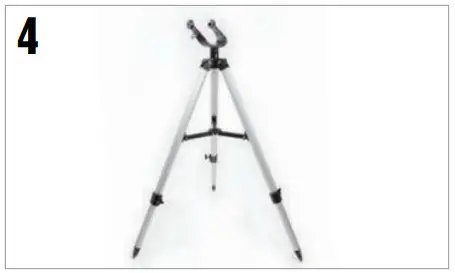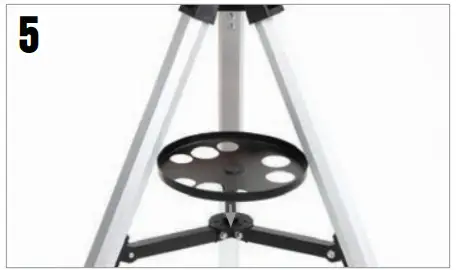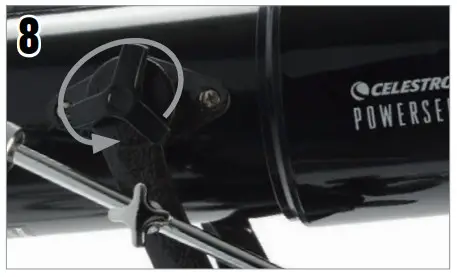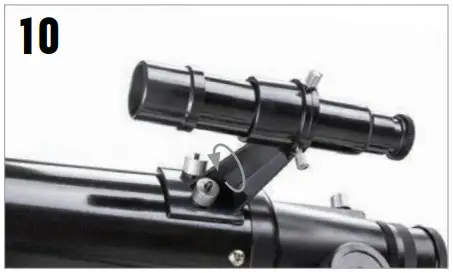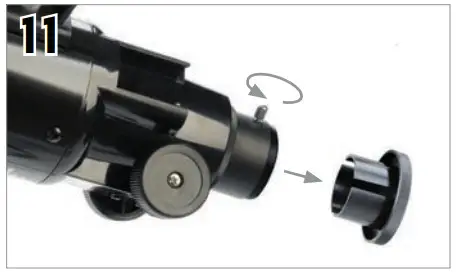 QUICK SETUP GUIDEPower Speaker 80AZS#21087
QUICK SETUP GUIDEPower Speaker 80AZS#21087
- Unpack your telescope and verify that all parts are present. Your PowerSeeker 80AZS includes an optical tube with two threaded mounting bolts, a tripod with a center support bracket, two eyepieces, a 3x Barlow lens, a finderscope, an erect image diagonal, and an eyepiece accessory tray.

- To set up the tripod, spread the legs outward until they are fully extended and push down the center leg brace.

- Extend the center portion of each of the three tripod legs down about 6 to 12 inches. Use the tightening screw on each leg to secure the extended leg in place.

- Check to ensure that all three legs are the same height once extended to provide a level platform for the telescope.

- Place the eyepiece accessory tray on top of the tripod’s center leg brace. Thread the tray into the threaded hole in the center of the leg brace until it is fully seated.

- If necessary, rotate the accessory tray counterclockwise until the accessory holes are not covered by the leg brace arms as shown here.

- Locate the optical tube and insert the attached slow motion control rod into the hole on the mount.

- Line up the tube with the holes on the mount and secure the tube to the mount using the two threaded mounting bolts. Tighten to secure in place.

- Remove the knurled nuts on the threaded posts at the focuser end of the telescope tube.

- Locate the finderscope and remove plastic caps on the front and back of the lens. Orient the finderscope so that the longer lens is facing towards the front of the tube as shown here. Place finderscope over the posts on the tube and replace knurled nuts to secure.

- Loosen the screws on the focuser so they do not obstruct the inner diameter of the focuser. Remove the plastic cap covering the end of the focuser.

- Locate the diagonal and remove the plastic covers. Insert the barrel of the diagonal into the focuser and secure in place by tightening the set screws.

- Insert the barrel of the 20mm eyepiece into the diagonal and tighten the set screw, being careful not to overtighten.

- Remove the lens cap from the front of the telescope. To observe, look through the eyepiece as shown above. Focus the image by turning the knobs below the focuser.

- For additional magnification, you can use the included 3x Barlow lens. Place the Barlow lens in the diagonal in place of the eyepiece. Remove the cap from the Barlow.


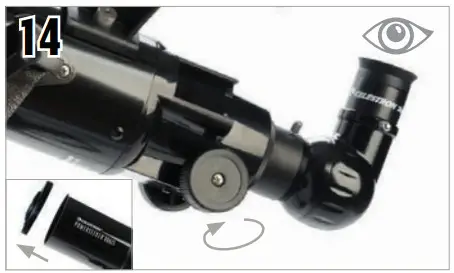
- Next, insert the barrel of the 20mm eyepiece into the Barlow and tighten the set screws to secure it in place.

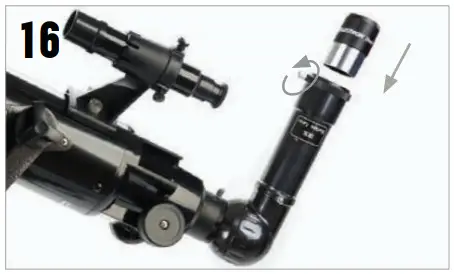
For more information on this product or to download the instruction manual, please visit the respective product page on celestron.com ![]()
![]()
![]()
ALIGNING THEFINDERSCOPEThe finder is one of the most important parts of your telescope. It helps you locate objects and center them in the eyepiece. The fi rst time you assemble your telescope, you need to align the finder to the telescope’s main optics. It’s best to do this during the day*.![]()
![]()
![]()
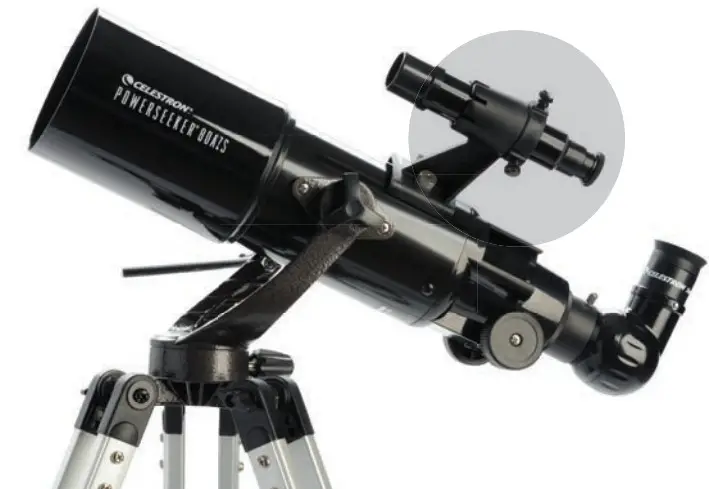

- CHOOSE A TARGETTake the telescope outside during the day and find an easily recognizable object, like a streetlight, license plate or sign. The object should be as far away as possible, but at least a quarter-mile away.

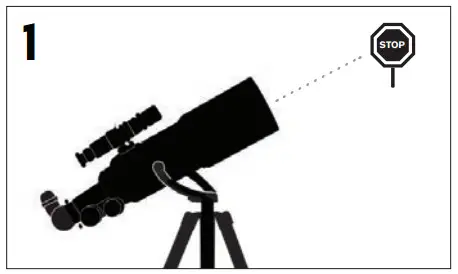
- CENTER THE TARGET IN THE EYEPIECE Look through the telescope using your lower-powered 20mm eyepiece. Move the telescope until the object you chose lies in the center of the view. If the image is blurry, gently turn the focus knobs on either side of the telescope until it comes into sharp focus.NOTE: The image in your telescope may appear inverted. This is perfectly normal in an astronomical telescope.

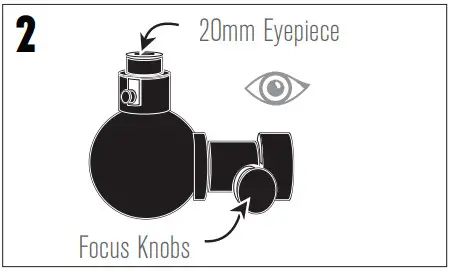
- LOOK THROUGH FINDERSCOPEOnce the object is centered in your 20mm eyepiece, look through the finderscope and locate the crosshair reticle.

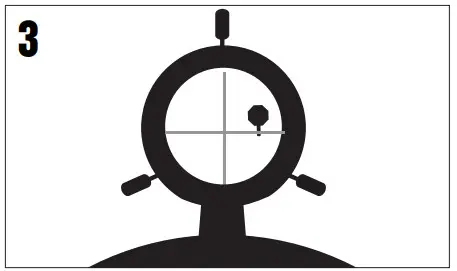
- ADJUST THE FINDERSCOPEWithout moving the telescope, use the three finger knobs surrounding in the finderscope bracket to move the finder around until the crosshair appears over the same object you are observing in the telescope’s 20mm eyepiece.TIP: Try adjusting one screw at a time. Loosen one screw by half a turn and tighten another by the same amount to ensure the finderscope is securely held in place.


- YOUR FINDERSCOPE IS NOW ALIGNED!It should not require realignment unless it is bumped or dropped.


YOUR FIRST NIGHT OUTTHE MOONThe best and easiest target for you to try to view fi rst is the Moon. Try observing the Moon at different points in its phase cycle. The best time to view the Moon is from two days after a New Moon up to a few days before a Full Moon. During this period, you will be able to see the most detail in the craters and lunar mountain ranges.


- With the Moon visible in the sky, set up your telescope with the 20mm eyepiece installed.

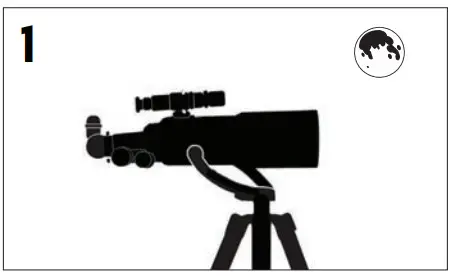
- Move the telescope so that it is roughly pointing toward the Moon.

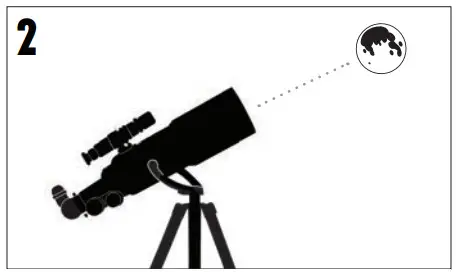
- Look through the finderscope and locate the crosshair reticle. Continue moving the telescope until the crosshair appears over the Moon.


- Look through the telescope’s 20mm eyepiece. Gently turn the focus knobs to adjust the sharpness of the image.

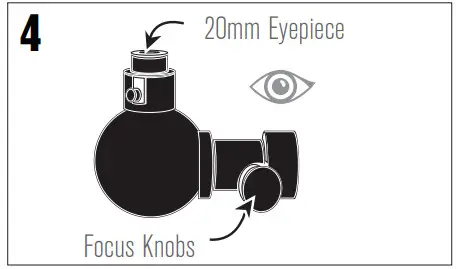
- CONGRATULATIONS!YOU HAVE NOW OBSERVED YOUR FIRST CELESTIAL OBJECT!To get a closer view of the Moon, loosen the set screws on the focuser and remove the 20mm eyepiece. Replace it with your 4mm eyepiece and tighten the set screws to secure it in place. The 4mm eyepiece will give you signifi cantly more magnifi cation, making the Moon appear much larger.NOTE: You may need to adjust the focus knobs when you change eyepieces, so make sure you are getting the sharpest image possible.


- You can view many other celestial objects, such as planets, star clusters and nebulae using this same technique if you know where to fi nd them in the night sky.
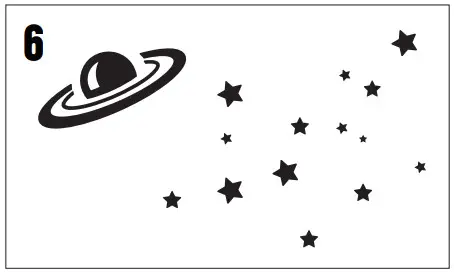



References
Celestron – Telescopes, Telescope Accessories, Outdoor and Scientific Products
Technical Support | Celestron
[xyz-ips snippet=”download-snippet”]


